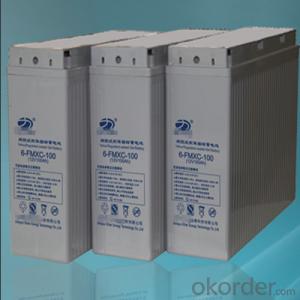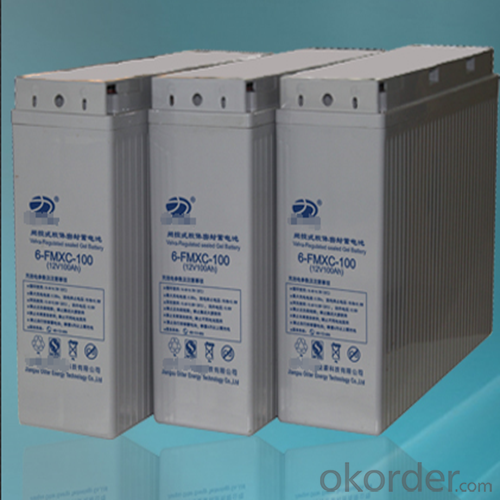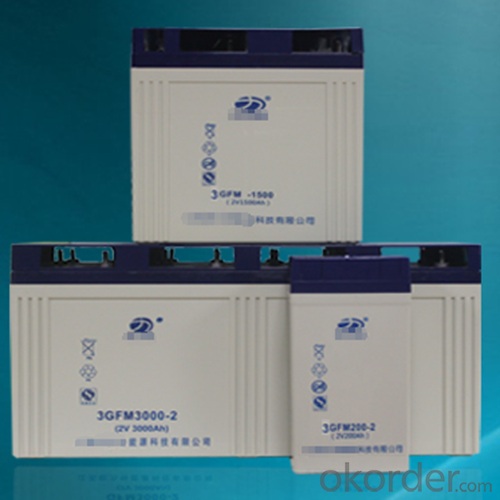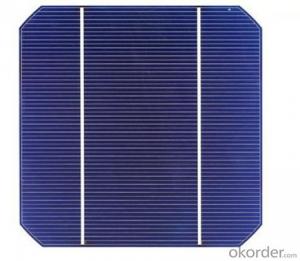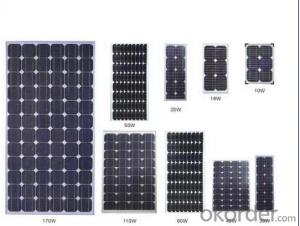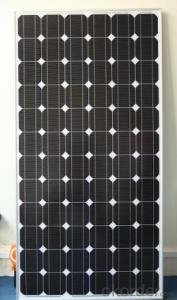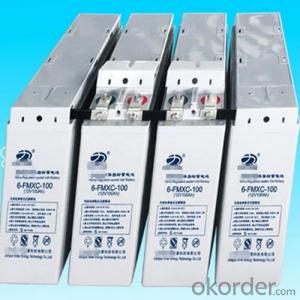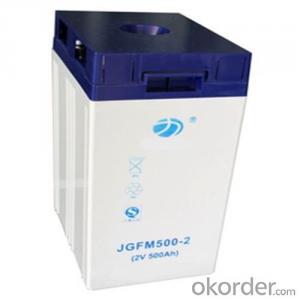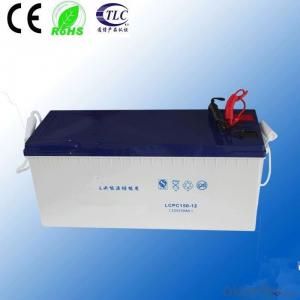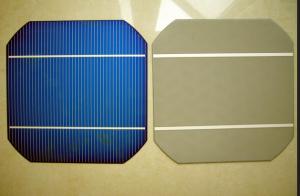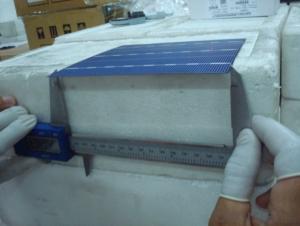Powerfilm Solar Cells Colloidal Battery 12V Series for Communication
- Loading Port:
- China main port
- Payment Terms:
- TT or LC
- Min Order Qty:
- 1 pc
- Supply Capability:
- 10000 pc/month
OKorder Service Pledge
OKorder Financial Service
You Might Also Like
Structure of Product Descrtption:
What is the product?
The FMXA/FMXC (Front Terminal) Series is especially designed for telecommunication use with 12 years design life in float service. By combining the newly developed paste formula with up-to-date AGM structures, this range features 12 years design life and Front Access connection for fast, easy installation and maintenance. This series is highly suited for telecom applications, UPS systems and other back up applications.
What is the purpose of the product?
· Telecommunication
· Control Equipments
· UPS systems
· Communication Equipments
· Medical Equipments
· Emergency Power Systems
What advantages do products have ?
12 years design life at floating condition
Wide operating temperature range from -15°C to 55°C
Advanced paste formula with increased recharge efficiency
Front access terminal with standard width for 19” and 23” ETSI racks
30% decreased float current lead to excellent high temperature resistance
Thick flat plate with high Tin low Calcium alloy
Low self discharge
Excellent deep discharge recovery capability
Main feature of the product
*safety and reliable
*environmental friendly and fast delivery
*low self diacharge
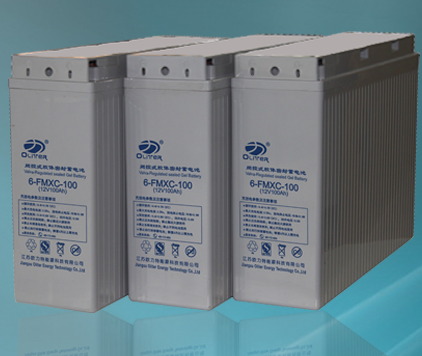
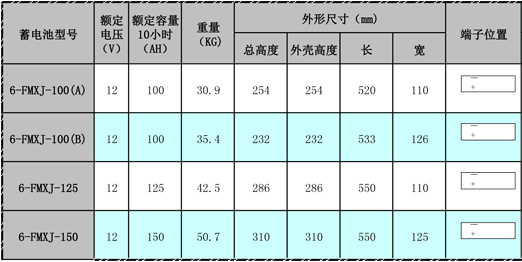
FAQ:
*Question:How do you pack your products?
Answer:We have rich experience on how to pack the panels to make sure the safety on shipment when it arrives at the destination.
*Question:Can you do FOB for us?
Answer:Yes, we can do it for you .
*Question:How long can we receive the goods after purchase?
Answer:In the purchase of product within three working days, We will arrange the factory delivery as soon as possible. The perfect time of receiving is related to the state and position of customers. Commonly 7 to 10 working days can be served.
Principles of how solar cell works
Solar power is amazing. On average, every square meter of Earth's surface receives 164 watts of solar energy. In other words, you could stand a really powerful (150 watt) table lamp on every square meter of Earth's surface and light up the whole planet with the Sun's energy! So, we want to exploit resources, and solar (or photovoltaic) cells appearance, it converts the sun’s energy into electricity. Whether they’re adorning your calculator or orbiting our planet on satellites, they rely on the the photoelectric effect: the ability of matter to emit electrons when a light is shone on it.
Steps of how solar cell works
Sunlight is composed of miniscule particles called photons, which radiate from the sun. As these hit the silicon atoms of the solar cell, they transfer their energy to loose electrons, knocking them clean off the atoms. The photons could be compared to the white ball in a game of pool, which passes on its energy to the coloured balls it strikes.
A solar cell is a sandwich of two different layers of silicon that have been specially treated or doped so they will let electricity flow through them in a particular way. The lower layer is doped so it has slightly too few electrons. It's called p-type or positive-type silicon (because electrons are negatively charged and this layer has too few of them). The upper layer is doped the opposite way to give it slightly too many electrons. It's called n-type or negative-type silicon.
The electrons use this energy to jump across the barrier into the upper, n-type layer and escape out into the circuit. Flowing around the circuit, the electrons make the lamp light up.
Energy Loss in a Solar Cell when it is working
Visible light is only part of the electromagnetic spectrum. Electromagnetic rad­iation is not monochromatic -- it's made up of a range of different wavelengths, and therefore energy levels.
Light can be separated into different wavelengths, which we can see in the form of a rainbow. Since the light that hits our cell has photons of a wide range of energies, it turns out that some of them won't have enough energy to alter an electron-hole pair. They'll simply pass through the cell as if it were transparent. Still other photons have too much energy. Only a certain amount of energy, measured in electron volts (eV) and defined by our cell material (about 1.1 eV for crystalline silicon), is required to knock an electron loose. We call this the band gap energy of a material. If a photon has more energy than the required amount, then the extra energy is lost. (That is, unless a photon has twice the required energy, and can create more than one electron-hole pair, but this effect is not significant.) These two effects alone can account for the loss of about 70 percent of the radiation energy incident on our cell.
- Q: What is the role of solar cells in powering remote monitoring systems?
- Solar cells play a crucial role in powering remote monitoring systems by converting sunlight into electricity. These systems are often installed in remote locations where access to traditional power sources is limited or non-existent. Solar cells provide a sustainable and reliable source of energy to continuously power these systems, allowing for continuous monitoring and data collection even in remote areas.
- Q: How do solar cells perform in areas with high winds?
- Solar cells can perform well in areas with high winds as long as they are properly installed and secured. However, excessive wind speeds can potentially damage or displace the solar panels, affecting their efficiency. To mitigate this, appropriate mounting systems and anchoring techniques can be used to ensure the stability and durability of solar installations in windy areas.
- Q: How do solar cells perform in areas with limited space for installation?
- Solar cells can still perform well in areas with limited space for installation, thanks to advancements in technology. Compact and efficient solar panels are designed to maximize energy production even in small areas. Additionally, innovative installation techniques such as rooftop solar panels or solar canopies can help utilize available space effectively.
- Q: Can solar cells be used for powering electric vehicles charging stations?
- Yes, solar cells can be used to power electric vehicle charging stations. Solar panels can convert sunlight into electricity, which can then be used to charge electric vehicles. This helps to utilize renewable energy sources and reduce the carbon footprint associated with charging electric vehicles.
- Q: What is the payback period for installing solar cells?
- The payback period for installing solar cells can vary depending on various factors such as the cost of installation, the amount of electricity generated, and the local energy rates. However, on average, solar panel systems typically have a payback period ranging from 5 to 10 years.
- Q: What is the best sales solution for solar power cells?
- I guess you should learn as much information as you can about solar power cells. In this way, your client would trust you and finally buy solar power cells from you.
- Q: How do solar cells handle power fluctuations?
- Solar cells handle power fluctuations through a process called maximum power point tracking (MPPT), which optimizes the output power of the cell. MPPT algorithms continuously monitor the voltage and current of the solar cell and adjust the load resistance to ensure that the cell operates at its maximum power point, even in the presence of fluctuations in solar irradiance or temperature. This allows solar cells to efficiently convert sunlight into electricity and adapt to changing environmental conditions.
- Q: Can solar cells be used for powering airports?
- Yes, solar cells can be used for powering airports. Solar panels can generate electricity from sunlight, which can be used to power various airport operations such as lighting, air conditioning, and charging stations for electric vehicles. Additionally, airports often have large open spaces, such as runways and parking lots, which can be utilized for installing solar panels and harnessing solar energy. This can not only reduce the airport's carbon footprint but also provide a more sustainable and cost-effective energy solution.
- Q: What is the impact of snow accumulation on solar cell performance?
- Snow accumulation can significantly reduce the performance of solar cells. The presence of snow on the surface of solar panels prevents sunlight from reaching the cells, thereby reducing their ability to generate electricity. Additionally, the weight of the snow can cause structural damage to the panels and potentially lead to their failure. Therefore, snow accumulation must be cleared promptly to ensure optimal solar cell performance.
- Q: Can solar cells be used to power homes?
- Yes, solar cells can be used to power homes. Solar photovoltaic (PV) systems convert sunlight into electricity, which can then be used to power various appliances and lighting in households. These systems typically consist of solar panels installed on rooftops or other sunny areas, along with inverters and batteries to store excess energy for use during non-sunny periods or at night. With advances in technology and decreasing costs, solar power has become an increasingly viable and sustainable option for homeowners to generate their own electricity.
Send your message to us
Powerfilm Solar Cells Colloidal Battery 12V Series for Communication
- Loading Port:
- China main port
- Payment Terms:
- TT or LC
- Min Order Qty:
- 1 pc
- Supply Capability:
- 10000 pc/month
OKorder Service Pledge
OKorder Financial Service
Similar products
Hot products
Hot Searches
Related keywords
